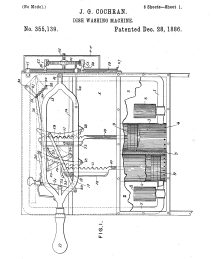Josephine Garis Cochran
Josephine Garis Cochran invented the first practical dishwasher and formed the Garis-Cochran Dish-Washing Co. to successfully manufacture and market it.
Born in Ashtabula County, Ohio, in 1841, Cochran had a natural talent for problem solving and invention. She took an interest in engineering, but she did not have access to the resources needed to pursue higher education in the subject, as such opportunities were rarely afforded to women at the time.
In 1858, she married William Apperson Cochran and the couple settled in Shelbyville, Illinois. Finding the task of dishwashing to be tedious and considering that it frequently resulted in chipped dishware, Cochran felt determined to develop a solution. According to the United States Patent and Trademark Office, Cochran vowed, “If nobody else is going to invent a [mechanical] dishwashing machine, I’ll do it myself.” In 1883, when Cochran’s husband passed away and she was left with many unpaid debts and little cash, her dream of inventing a mechanical dishwashing machine also became a necessity.
Having recruited some assistance from a young mechanic named George Butters, Cochran began working on her prototype. She filed for her first patent under the name “J.G. Cochran” in 1885, and it was granted in 1886.
To produce and sell her machine, Cochran first tried working with existing manufacturing firms, but she eventually decided to open her own, where Butters would serve as the foreman. “I couldn’t get men to do the things I wanted in my way until they had tried and failed in their own. And that was costly for me,” Cochran explained. “They knew I knew nothing, academically, about mechanics, and they insisted on having their own way with my invention until they convinced themselves my way was the better, no matter how I had arrived at it.”
Cochran’s design involved a set of wire compartments, each created to fit plates, cups or saucers. The compartments were placed inside a wheel that lay flat inside a copper boiler, while a motor turned the wheel, pumping hot soapy water from the bottom of the boiler. Although other dishwashing machines had been developed before hers, Cochran’s was the first one with racks specifically designed to hold the dishes in place, as well as the first to use water pressure instead of scrubbers. Additionally, Cochran’s design was far more convenient in comparison to previous machines that had required users to pour boiling water over the dishes.
As she began to market her dishwashing machine through her own company, Cochran first focused on selling to businesses including hotels and large restaurants. The large-sized model of the Garis-Cochran dishwasher, which could wash and dry an impressive 240 dishes in just two minutes, also sold well to hospitals and colleges.
In 1890, Cochran moved to Chicago, and a few years later, her machine was showcased in the World Columbian Exposition of 1893 – a great opportunity for publicity and sales. Having won a prize for her dishwasher, she later exhibited it at fairs in Massachusetts, New York and Missouri.
While Cochran’s machine proved successful among businesses, it initially failed to sell to individual consumers. At the time, homes' hot water heaters could not supply the amount of hot water the dishwasher required, and the machines were said to leave a soapy residue on the dishes. It was not until the 1950s that increased availability of hot water in the home, effective dishwashing detergent and a change in attitudes toward housework made dishwashers popular with the general public.
The Garis-Cochran Manufacturing Co. became part of KitchenAid®, and in 1949, the first KitchenAid dishwasher based on Cochran's design was introduced to the public. Today, the dishwasher is a standard appliance in most American households.
Cochran not only was a persistent inventor, manufacturer and salesperson, but she even oversaw installations, and she continued to develop and patent improvements on her invention. Reflecting on her innovative journey, she said, “If I knew all I know today when I began to put the dishwasher on the market, I never would have had the courage to start. But then, I would have missed a very wonderful experience.”
